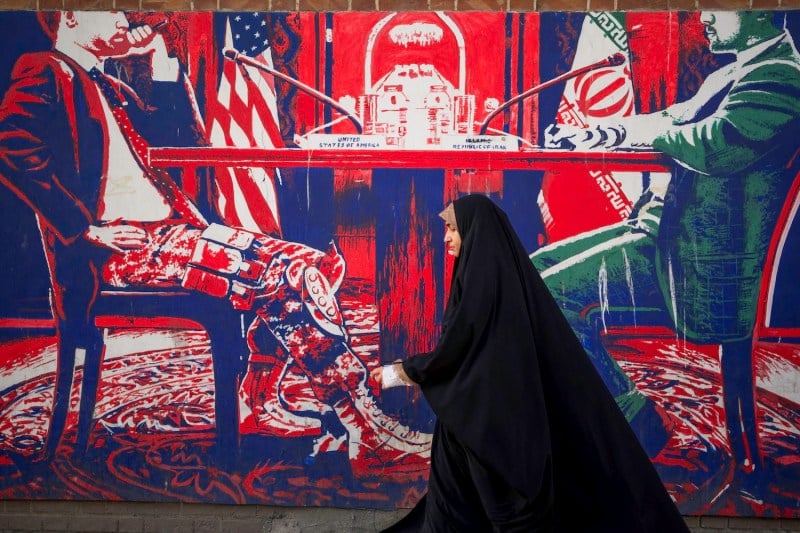The United States Needs a Nuclear Operation Warp Speed

The United States Needs a Nuclear Operation Warp Speed
A nuclear energy resurgence is vital to meet rising electricity demand.
The shuttered Three Mile Island nuclear power plant near Middletown, Pennsylvania, on Oct. 10, 2024. Chip Somodevilla/Getty Images
A new Pew Research Center poll finds partisan polarization among Americans at its highest level in decades. As just the latest example, House Republicans passed a budget bill without a single Democratic vote. But there is at least one issue on which both sides of the aisle can increasingly agree: The United States needs to re-embrace nuclear energy and retake its role as a global leader in nuclear power technology.
Last month, U.S. President Donald Trump signed four executive orders aimed at dramatically increasing nuclear power generation in the United States. While those orders correctly identify several areas for reform, the executive branch cannot overcome existing barriers on its own. Democrats and Republicans in Congress need to strengthen efforts to build a reinvigorated nuclear sector in the United States, as exemplified by a bipartisan bill introduced in May aimed at developing an export strategy for civilian nuclear energy.
A new Pew Research Center poll finds partisan polarization among Americans at its highest level in decades. As just the latest example, House Republicans passed a budget bill without a single Democratic vote. But there is at least one issue on which both sides of the aisle can increasingly agree: The United States needs to re-embrace nuclear energy and retake its role as a global leader in nuclear power technology.
Last month, U.S. President Donald Trump signed four executive orders aimed at dramatically increasing nuclear power generation in the United States. While those orders correctly identify several areas for reform, the executive branch cannot overcome existing barriers on its own. Democrats and Republicans in Congress need to strengthen efforts to build a reinvigorated nuclear sector in the United States, as exemplified by a bipartisan bill introduced in May aimed at developing an export strategy for civilian nuclear energy.
Operationalizing a U.S. nuclear resurgence requires agreeing on an ambitious goal and working together to realize it. Just as Trump in his first term announced Operation Warp Speed to bring a COVID-19 vaccine to market, both parties should set aside partisan differences and back a Nuclear Operation Warp Speed with a target of building 20 gigawatts of new nuclear capacity by 2035.
Nuclear energy is undergoing a resurgence. Beyond the growing recognition among environmentalists that curbing greenhouse gas emissions will be easier and cheaper if nuclear is part of the mix, there are two additional reasons for the focus on nuclear energy that have broad bipartisan support.
First, after two decades of flat electricity demand, it is set to surge in the United States in the coming years to meet the demands of data centers for artificial intelligence, in addition to the electrification of cars, heating systems, and industrial processes. According to a new report by the International Energy Agency (IEA), electricity demand from data centers worldwide is set to more than double by 2030. Given the need for data centers to rely on large quantities of power that runs 24/7 and 365 days per year, nuclear energy’s high reliability makes it particularly attractive.
For all the attention paid to surging natural gas investment to meet the power needs of AI, the report finds that by 2035 nuclear power will contribute just as much as gas to meeting increases in data center electricity demand—and the longer-term potential is even larger given the longer time frame for advanced nuclear technology to come online. Big tech firms, including Microsoft, Google, and Amazon, have all signed deals to buy new nuclear power for data centers—and even to restart a reactor at Three Mile Island. Just last week, Meta signed a 20-year deal with Constellation to buy power from a nuclear plant in Illinois that was at risk of prematurely closing.
Second, the United States’ geostrategic influence and national security are undermined by ceding nuclear leadership to Russia and China. Russia is building more nuclear power plants abroad today than any other country, including in Bangladesh, China, Egypt, India, Iran, and Turkey. When domestic construction is included, China leads the world in the build-out of nuclear power. Of the 58 reactors currently under construction in 17 countries worldwide, 80 percent are of Russian or Chinese origin. These include not only traditional reactor designs, but also advanced nuclear technologies that will dominate future growth in the nuclear energy market, including small modular reactors.
Both Beijing and Moscow view nuclear energy leadership as a geostrategic priority. They provide vast state financing to state-owned nuclear companies, which then offer emerging and developing countries low-interest loans and contracts that allow them to build, own, and operate the plants. In this way, China and Russia not only make it hard for companies from other nations to compete. They also ensure that buyers become indebted to them—and dependent on their expertise and supply of nuclear fuel. These arrangements allow China and Russia to deepen their economic and political influence over the countries buying their technology. The United States prides itself on its safety standards, security culture, and nonproliferation stance, but when the United States is not the technology supplier, it does not spread those standards, cultures, and policies to the purchasing countries.
To put the goal of 20 gigawatts (GW) of new nuclear power in the United States by 2035 in context, this compares to current U.S. nuclear generation capacity of around 100 GW. Although only about 6 GW of new capacity has been added over the past 35 years, more than 50 GW were added in the 1980s, showing that major buildouts have been done before. While the goal is ambitious, fast-tracking even a handful of initial reactors to be under construction by 2030 would build the momentum for additional projects by establishing robust supply chains and a ready workforce.
While the U.S.-China race for AI leadership demands power be added to the grid more quickly than 2035, focusing exclusively on speed would lock the United States into currently operating nuclear technology and forgo the longer-term opportunity to build leadership in advanced nuclear technologies that will take time to develop.
Elements of Trump’s executive orders offer promising avenues for reforming U.S. nuclear policy and align broadly with bipartisan reforms set forth in the 2024 ADVANCE Act. Thoughtful implementation will be necessary to avoid introducing delays due to regulatory churn and undermining necessary safeguards, nonproliferation controls, and public confidence in nuclear energy.
A successful Nuclear Operation Warp Speed should bring down costs, eliminate delays, and ensure a secure fuel supply. Today, the key challenge for nuclear energy is cost. The causes of delays and cost overruns include immature designs and supply chains, regulatory burdens, other first-of-a-kind issues, and megaproject management failures. When these issues are addressed, analysis shows that the costs of nuclear energy deployed at scale can compete favorably with other clean energy sources on a power generation basis. What’s more, the overall system costs for generation and transmission of low-carbon electric power supply are much lower when nuclear energy is included.
The list of steps the Trump administration and Congress must take to overcome these challenges is long. It requires addressing issues ranging from spent nuclear fuel disposition to workforce development to fuel supply. To start, policymakers should focus on three key policy reforms: financing, regulation, and exports.
First, the government should increase financial support for new nuclear reactors and fuel supply infrastructure. Doing so is justified to value the carbon-free electricity; to compete with extensive Russian and Chinese government support; to overcome the extra costs of first-of-a-kind projects to restart a shuttered U.S. nuclear industry; and to address the mismatch between a nuclear plant’s 60- to 80-year lifespan and the 30-year cost recovery period expected by financial markets.
One promising approach is a milestone-based payment model, similar to that used by NASA to jump-start a private space transportation sector in the United States. Existing loan guarantees and tax credits are effective tools, and Energy Secretary Chris Wright was right to encourage Congress to retain current nuclear tax incentives. The Defense Production Act is also a powerful tool to secure the nuclear fuel supply, as proposed in Trump’s executive orders. Federal agencies can use government procurement of future power generation to stimulate demand.
Second, the federal government should reduce nuclear regulatory and permitting burdens while protecting public health and safety. Reform of the Nuclear Regulatory Commission (NRC) should streamline the environment review process, as a major new report from the Center on Global Energy Policy explains. Trump’s orders also direct NRC reform—including streamlining regulations, establishing fixed deadlines for reviews, reorganizing the structure, reducing staffing, and establishing a process for more and faster licensing—although in ways that risk undermining the efficiency and effectiveness of the agency if they are implemented without adequate care and independence.
Congress should eliminate the so-called mandatory hearing, which only adds time and cost to new reactor licensing. The NRC should improve its procedures based on the lessons of the last U.S. nuclear reactors to come online in Georgia in 2023 and 2024, which ran far over cost and schedule.
Third, the U.S. government should support its nuclear industry’s global leadership by providing diplomatic support and export financing for companies building projects abroad. Bipartisan bills such as the Civil Nuclear Export Act, as well as Trump’s new executive orders, aim to increase the Export-Import Bank’s financing capabilities for U.S. nuclear projects in other countries. In its reauthorization of the Development Finance Corporation this year, Congress should give the agency more resources to expand its nuclear expertise and its investment authorities.
Finally, the United States should keep pressing the World Bank to lift its restrictions on financing nuclear projects and develop its capacity for assistance in this area, as World Bank President Ajay Banga suggested earlier this year.
In today’s new age of great-power competition, the United States faces three related threats: competition from China and Russia for leadership in the construction and export of nuclear technology; competition for leadership in the transformational new technology of artificial intelligence, which requires vast amounts of electricity; and competition for leadership in the clean energy technologies that will be necessary to address the threat of climate change in the decades to come. Nuclear energy is key to meeting all three competitive challenges.
Democrats and Republicans should continue making nuclear energy a rare bright spot of bipartisan cooperation, working together to build out nuclear power, reinvigorate the U.S. nuclear industry, and assert leadership in advanced nuclear technology.
Jason Bordoff is a columnist at Foreign Policy, the founding director of the Center on Global Energy Policy at Columbia University’s School of International and Public Affairs, a professor of professional practice in international and public affairs, co-founding dean emeritus at the Columbia Climate School, and a former senior director on the staff of the U.S. National Security Council and special assistant to former U.S. President Barack Obama. X: @JasonBordoff
Ashley Finan is a global fellow at the Center on Global Energy Policy, a former chief science officer for the National and Homeland Security Directorate at Idaho National Laboratory, and the former founding director of the National Reactor Innovation Center and Nuclear Innovation Alliance.
Matt Bowen is a senior research scholar at the Center on Global Energy Policy, a former nuclear policy fellow at the Clean Air Task Force, a former senior policy fellow at the Nuclear Innovation Alliance, a former associate deputy assistant secretary in the Office of Nuclear Energy, and a former senior advisor in the Office of Nonproliferation and Arms Control at the U.S. Department of Energy. X: @mbowen92
Stories Readers Liked
In Case You Missed It
A selection of paywall-free articles

Four Explanatory Models for Trump’s Chaos
It’s clear that the second Trump administration is aiming for change—not inertia—in U.S. foreign policy.





















Join the Conversation
Commenting is a benefit of a Foreign Policy subscription.
Subscribe
Subscribe
Already a subscriber?
.
View Comments
Join the Conversation
Join the conversation on this and other recent Foreign Policy articles when you subscribe now.
Subscribe
Subscribe
Not your account?
View Comments
Join the Conversation
Please follow our comment guidelines, stay on topic, and be civil, courteous, and respectful of others’ beliefs.
View Comments
Change your username |
Log out
Change your username:
CANCEL
Confirm your username to get started.
The default username below has been generated using the first name and last initial on your FP subscriber account. Usernames may be updated at any time and must not contain inappropriate or offensive language.